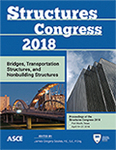Structures Congress 2018
Corrosion in the Substructure of a Pedestrian Bridge at YSU: A Case Study
Publication: Structures Congress 2018: Bridges, Transportation Structures, and Nonbuilding Structures
ABSTRACT
A pedestrian bridge linking Moser Hall and Cushwa Hall at Youngstown State University (YSU), Youngstown, Ohio, was built almost 40 years ago. All three hammerhead pier caps supporting the bridge deck have experienced severe corrosion at the bottom. This corrosion has led to spalling of concrete at multiple locations and thereby exposed the reinforcing steel bars to open air facilitating more corrosion. An investigative study was undertaken to identify the causes of corrosion in these substructure units and to propose some viable remedies to this problem. The Schmidt hammer and profoscope were used to approximate the concrete strength, reinforcing steel bar locations, and clear covers. Reviews of previous research suggest that substructure corrosion can likely be carbonation-induced. Although carbonation-induced corrosion is a slower process in a dry environment and mostly occurs in older structures, it was predicted that the corrosion in those pier caps was due to the carbonation of concrete. Carbonation reactions take place on the outer surface of concrete and gradually penetrate through the concrete cover resulting in a low pH in the concrete. A full-scale structural analysis revealed no major reduction in strength of the pier caps. Physical inspections were conducted to ensure no major deficiency exists in the corroded concrete and steel reinforcement. After considering various repair methods, patching with fiber-reinforced concrete or low-slump dense concrete coupled with hydrophobic coating, and cathodic protection at damaged locations were suggested as the best remedial measures to protect the substructure from further deterioration.
Get full access to this article
View all available purchase options and get full access to this chapter.
REFERENCES
ACI 222. R-01. (2010). Protection of Metals in Concrete against Corrosion. Technical Report (Reapproved 2010).
ACI Committee 562. (2013). Code Requirements for Evaluation, Repair, and Rehabilitation of Concrete Buildings (ACI 562-13) and Commentary. American Concrete Institute.
Apostolopoulos, C. A. & Papadopoulos, M. P. (2007). Tensile and low cycle fatigue behavior of corroded reinforcing steel bars s400. Construction and Building Materials 21(4): 855–864.
ASTM, C. (1997). 805, Standard test method for rebound number of hardened concrete. ASTM, USA.
Bertolini, L., Elsener, B., Pedeferri, P., Redaelli, E., & Polder, R. B. (2013). Corrosion of steel in concrete: prevention, diagnosis, repair. John Wiley & Sons.
Bier, T. A., (1987). Influence of Type of Cement and Curing on Carbonation Progress and Pore Structure of Hydrated Cement Paste. Materials Research Society Symposium, V. 85, pp. 123–134.
Binici, H., & Aksoğan, O. (2006). Sulfate resistance of plain and blended cement. Cement and Concrete Composites, 28(1), 39–46.
Brencich, A., Cassini, G., Pera, D., & Riotto, G. (2013). Calibration and reliability of the rebound (Schmidt) Hammer test. Civil Engineering and Architecture, 1(3), 66–78.
Broomfield, J. P. (2006). Corrosion of steel in concrete: understanding, investigation and repair. CRC Press.
Bungey, J. H., Grantham, M. G., & Millard, S. (2006). Testing of concrete in structures. CRC Press.
Chen, E., & Leung, C. K. (2015). Finite element modeling of concrete cover cracking due to non-uniform steel corrosion. Engineering Fracture Mechanics, 134, 61–78.
Cook, W. (2014). Bridge failure rates, consequences, and predictive trends. Utah State University.
Gutberlet, T., Hilbig, H., & Beddoe, R. E. (2015). Acid attack on hydrated cement—Effect of mineral acids on the degradation process. Cement and Concrete Research, 74, 35–43.
Hannachi, S., & Guetteche, M. N. (2014). Review of the Rebound Hammer Method Estimating Concrete Compressive Strength on Site. In International Conference on Architecture and Civil Engineering (pp. 118–127).
Johnson, A. P., Lawler, J. S., Enser, D., Konda, T., & Backer, P. (2017). The Franklin Avenue Bridge Part 1: History, investigation, and rehabilitation. Concrete International, June, pp. 33–42.
Khan, I., François, R., & Castel, A. (2014). Prediction of reinforcement corrosion using corrosion induced cracks width in corroded reinforced concrete beams. Cement and concrete research, 56, 84–96.
Kim, J. K., Kim, C. Y., Yi, S. T., & Lee, Y. (2009). Effect of carbonation on the rebound number and compressive strength of concrete. Cement and Concrete Composites, 31(2), 139–144.
Lichtenstein, A. G. (1993). The silver bridge collapse recounted. Journal of performance of constructed facilities, 7(4), 249–261.
Luckovic, M., Savija, B., & Schlangen, E. (2014). Damage induced by continued corrosion in concrete repair systems. In SHCC3: Proceedings of the 3rd International RILEM Conference on Strain Hardening Cementitious Composites, Dordrecht, The Netherlands, 3-5 November 2014; RILEM.
McPolin, D. O., Basheer, P. A., & Long, A. E. (2009). Carbonation and pH in mortars manufactured with supplementary cementitious materials. Journal of Materials in Civil Engineering, 21(5), 217–225.
Pade, C., & Guimaraes, M. (2007). The CO 2 uptake of concrete in a 100 year perspective. Cement and Concrete Research, 37(9), 1348–1356.
Polder, R. B. (1998). Durability of marine concrete structures – field investigations and modeling. HERON, Vol. 50, No. 3, pp. 133–149.
RILEM, T. 124-SRC (1994) Draft recommendation for repair strategies for concrete structures damaged by reinforcement corrosion. Materials and Structures, 27(171), 415–436.
Sivakumar, A., & Santhanam, M. (2007). A quantitative study on the plastic shrinkage cracking in high strength hybrid fibre reinforced concrete. Cement and concrete composites, 29(7), 575–581.
Taylor, H. F. (1997). Cement chemistry. Thomas Telford, Villain, G., Thiery, M., & Platret, G. (2007). Measurement methods of carbonation profiles in concrete: Thermogravimetry, chemical analysis and gammadensimetry. Cement and Concrete Research, 37(8), 1182–1192.
Information & Authors
Information
Published In
Structures Congress 2018: Bridges, Transportation Structures, and Nonbuilding Structures
Pages: 111 - 124
Editor: James Gregory Soules, CB&I
ISBN (Online): 978-0-7844-8133-2
Copyright
© 2018 American Society of Civil Engineers.
History
Published online: Apr 17, 2018
Published in print: Apr 17, 2018
Authors
Metrics & Citations
Metrics
Citations
Download citation
If you have the appropriate software installed, you can download article citation data to the citation manager of your choice. Simply select your manager software from the list below and click Download.
